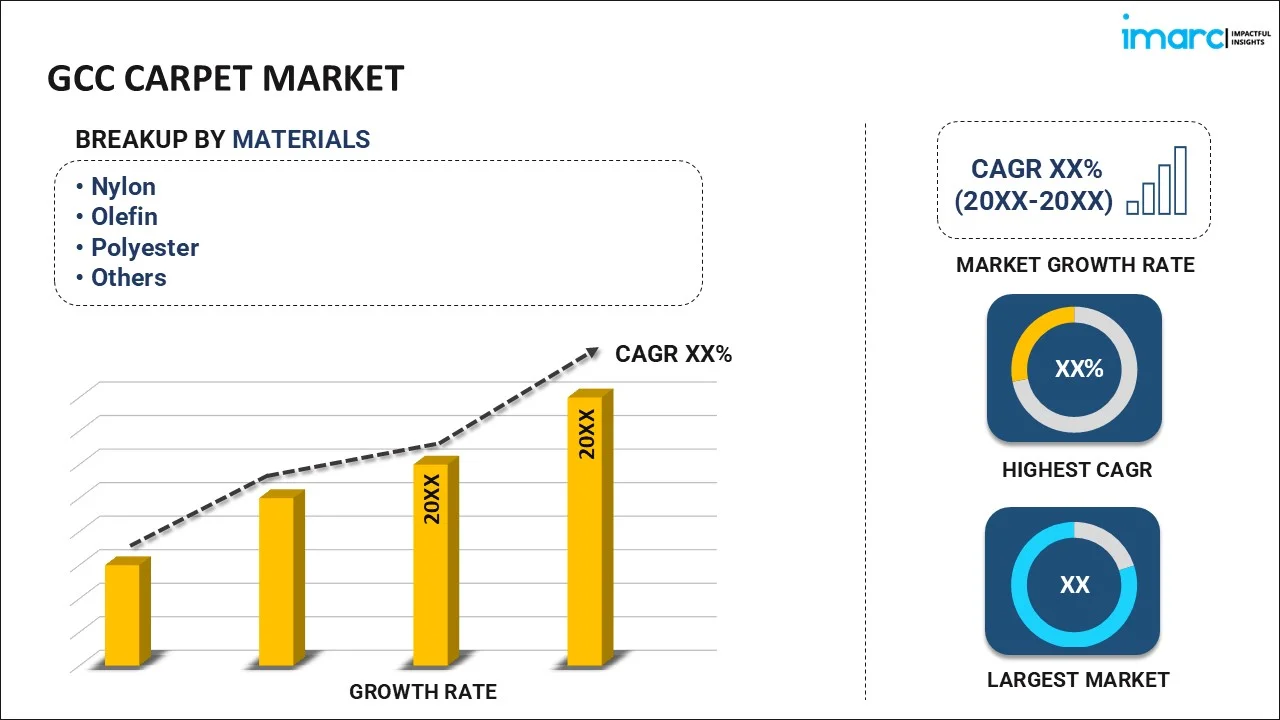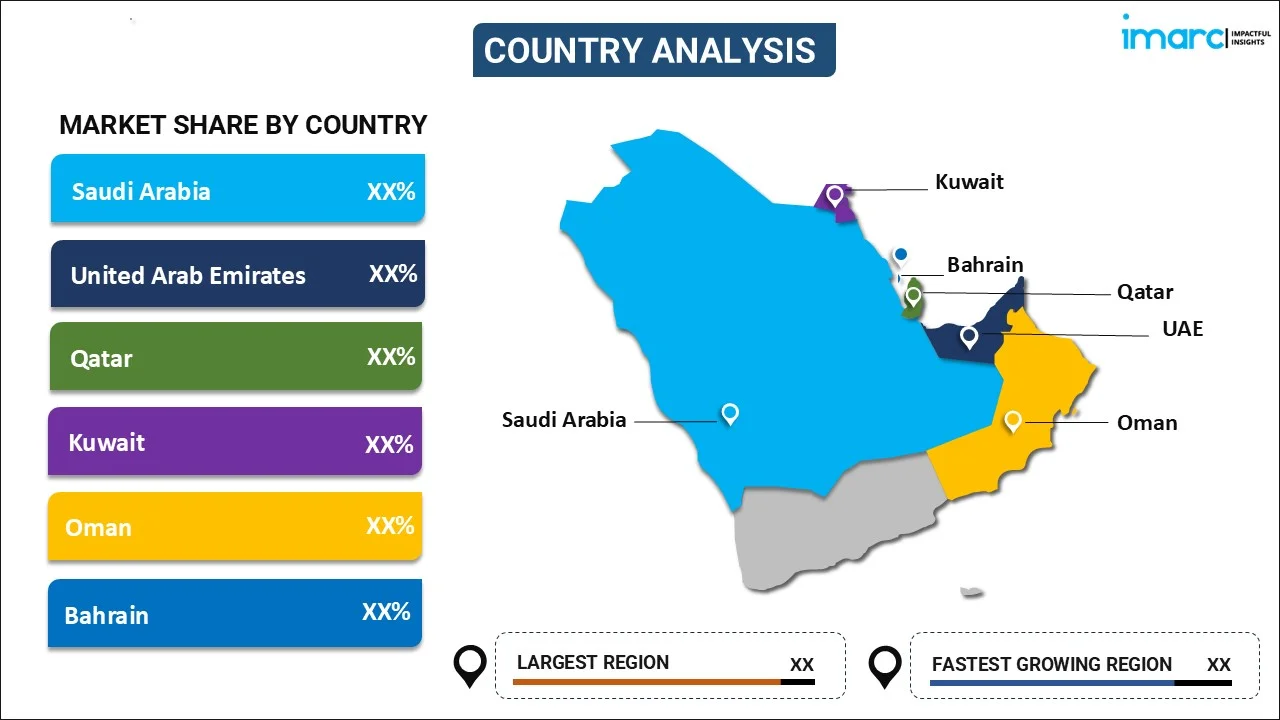
GCC Carpet Market Report by Material (Nylon, Olefin, Polyester, and Others), Price Point (Economy, Luxury), Sales Channel (Supermarkets and Hypermarkets, Specialty Stores, Online Stores), End User (Residential, Commercial), and Country 2025-2033
Market Overview:
The GCC carpet market size reached USD 1,246 Million in 2024. Looking forward, IMARC Group expects the market to reach USD 1,869 Million by 2033, exhibiting a growth rate (CAGR) of 4.6% during 2025-2033. Rapid urbanization and infrastructure development, the expanding hospitality sector, the increasing traditional and cultural significance, growing affluent population, aesthetic and design trends, and government initiatives and support represent some of the key factors driving the market.
|
Report Attribute
|
Key Statistics
|
|---|---|
|
Base Year
|
2024 |
|
Forecast Years
|
2025-2033
|
|
Historical Years
|
2019-2024
|
| Market Size in 2024 | USD 1,246 Million |
| Market Forecast in 2033 | USD 1,869 Million |
| Market Growth Rate (2025-2033) | 4.6% |
Carpet is a popular and versatile floor covering material that is widely used in both residential and commercial settings. It is typically made from woven or tufted fibers, which can be natural, such as wool, or synthetic, like nylon, polyester, or polypropylene. The soft and cushioned texture of the carpet provides a comfortable surface for walking, sitting, or playing, making it a preferred choice for living rooms, bedrooms, and play areas. One of the key advantages of carpet is its ability to insulate and retain heat, creating a warm and cozy atmosphere within indoor spaces. It also helps reduce noise levels by absorbing sound, contributing to a quieter environment. Carpet comes in a variety of colors, patterns, and textures, allowing for a wide range of design possibilities to match different interior styles and preferences. Additionally, it can hide minor imperfections on the subfloor and create a unified, aesthetically pleasing look for a room. Beyond its visual and tactile appeal, the carpet also offers practical benefits. It acts as a natural air filter, trapping dust, pollen, and other particles, thus improving indoor air quality. Regular vacuuming and cleaning can help maintain a healthier environment.
GCC Carpet Market Trends:
Changing consumer preferences and evolving design trends in the region are leading to a shift towards more contemporary and modern styles of carpets, which represents one of the key factors driving the growth of the market across the GCC region. In line with this, manufacturers are offering a diverse range of designs, patterns, and colors to cater to these evolving tastes, which is further driving the market growth. The GCC countries are experiencing significant urbanization and infrastructural development, including commercial buildings, hotels, and residential complexes. This is leading to an increased demand for carpets to furnish and decorate these spaces, which is driving the market growth. In addition to this, the region's flourishing tourism and hospitality industry, with an abundance of luxury hotels, resorts, and leisure destinations, is stimulating the demand for high-quality and aesthetically pleasing carpets, which is contributing to the market growth. Hospitality establishments often prioritize carpets as a key component of their interior design, which is further boosting the market growth. Apart from this, carpets hold immense cultural significance in the GCC countries, where they are often considered an essential part of the local heritage and traditions. Handwoven carpets are highly valued, and this cultural attachment drives the demand for carpets in both residential and commercial settings. Moreover, some GCC countries are implementing policies to support local industries, including carpet manufacturing. These initiatives, such as promoting local production and exports, are further creating a positive outlook for the market across the region.
GCC Carpet Market Segmentation:
IMARC Group provides an analysis of the key trends in each segment of the GCC carpet market report, along with forecasts at the regional and country levels for 2025-2033. Our report has categorized the market based on material, price point, sales channel, and end user.
Material Insights:

- Nylon
- Olefin
- Polyester
- Others
The report has provided a detailed breakup and analysis of the market based on the material. This includes nylon, olefin, polyester, and others.
Price Point Insights:
- Economy
- Luxury
A detailed breakup and analysis of the market based on the price point has also been provided in the report. This includes computer economy and luxury.
Sales Channel Insights:
- Supermarkets and Hypermarkets
- Specialty Stores
- Online Stores
A detailed breakup and analysis of the market based on the sales channel has also been provided in the report. This includes supermarkets and hypermarkets, specialty stores, and online stores.
End User Insights:
- Residential
- Commercial
A detailed breakup and analysis of the market based on the end-user has also been provided in the report. This includes residential and commercial.
Country Insights:

- Saudi Arabia
- UAE
- Qatar
- Oman
- Kuwait
- Bahrain
The report has also provided a comprehensive analysis of all the major regional markets, which include Saudi Arabia, the UAE, Qatar, Oman, Kuwait, and Bahrain.
Competitive Landscape:
The report has also provided a comprehensive analysis of the competitive landscape in the GCC carpet market. Competitive analysis such as market structure, key player positioning, top winning strategies, competitive dashboard, and company evaluation quadrant has been covered in the report. Also, detailed profiles of all major companies have been provided.
GCC Carpet Market Report Coverage:
| Report Features | Details |
|---|---|
| Base Year of the Analysis | 2024 |
| Historical Period | 2019-2024 |
| Forecast Period | 2025-2033 |
| Units | Million USD |
| Scope of the Report | Exploration of Historical and Forecast Trends, Industry Catalysts and Challenges, Segment-Wise Historical and Predictive Market Assessment:
|
| Materials Covered | Nylon, Olefin, Polyester, Others |
| Price Points Covered | Economy, Luxury |
| Sales Channels Covered | Supermarkets And Hypermarkets, Specialty Stores, Online Stores |
| End Users Covered | Residential, Commercial |
| Countries Covered | Saudi Arabia, UAE, Qatar, Oman, Kuwait, Bahrain |
| Customization Scope | 10% Free Customization |
| Post-Sale Analyst Support | 10-12 Weeks |
| Delivery Format | PDF and Excel through Email (We can also provide the editable version of the report in PPT/Word format on special request) |
Key Questions Answered in This Report:
- How has the GCC carpet market performed so far and how will it perform in the coming years?
- What has been the impact of COVID-19 on the GCC carpet market?
- What is the breakup of the GCC carpet market on the basis of material?
- What is the breakup of the GCC carpet market on the basis of price point?
- What is the breakup of the GCC carpet market on the basis of sales channel?
- What is the breakup of the GCC carpet market on the basis of end user?
- What are the various stages in the value chain of the GCC carpet market?
- What are the key driving factors and challenges in the GCC carpet market?
- What is the structure of the GCC carpet market and who are the key players?
- What is the degree of competition in the GCC carpet market?
Key Benefits for Stakeholders:
- IMARC’s report offers a comprehensive quantitative analysis of various market segments, historical and current market trends, market forecasts, and dynamics of the GCC carpet market from 2019-2033.
- The research study provides the latest information on the market drivers, challenges, and opportunities in the GCC carpet market.
- Porter's five forces analysis assist stakeholders in assessing the impact of new entrants, competitive rivalry, supplier power, buyer power, and the threat of substitution. It helps stakeholders to analyze the level of competition within the GCC carpet industry and its attractiveness.
- Competitive landscape allows stakeholders to understand their competitive environment and provides an insight into the current positions of key players in the market.
Need more help?
- Speak to our experienced analysts for insights on the current market scenarios.
- Include additional segments and countries to customize the report as per your requirement.
- Gain an unparalleled competitive advantage in your domain by understanding how to utilize the report and positively impacting your operations and revenue.
- For further assistance, please connect with our analysts.
 Request Customization
Request Customization
 Speak to an Analyst
Speak to an Analyst
 Request Brochure
Request Brochure
 Inquire Before Buying
Inquire Before Buying




.webp)




.webp)












